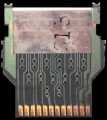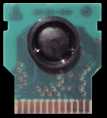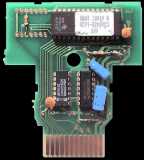
Atari 2600 cartridge-tech

Ever wondered, what those little imprinted numbers on the the top left on some end-labels mean (inside the red square)? Well, it's quite easy: the first two digits tell us the WEEK of production, the third digit tells the YEAR of production, i.e. this "Asterix" (PAL) was manufactured in the 47th week of 1983. Yet unknown is the meaning of the letter behind the production-date. If anyone knows, please inform us.





These are different (EP)ROM-types used in VCS cartridges. From left to right:
1. "normal" ROM with
electric shielding, taken from Atari's "Adventure"
2. "Eggdrop" ROM, taken from Atari's "Mario Bros."
3. "Eggdrop" #2 ROM, take from Activision's "Space Shuttle"
4. EPROM, taken from Atari's "32 in 1", the white sticker protects
the erase window
The "32 in 1" is quite special: besides the "TMS27C512", a 64Kbytes (512 divided by 8) EPROM by Texas Instruments, there are several other components on the PCB:
1. one binary counter (left
one of the two small chips)
2. one Inverter IC (yes, the right one)
3. four capacitors
4. two resistors
The 64K EPROM holds the 32 games (2K each). The binary counter is responsible for selecting, i.e. counting which game is currently selected by switching the VCS "Off" and "On" again. The big capacitors (blue) keep an electric charge to help the binary counter "memorize" its current value. The small capacitors (brown) are smoothing out the power going to the ICs.
Does anyone know why Atari used an EPROM instead of an "ordinary" ROM? Please tell us.